radiator CHEVROLET LUMINA 1993 1.G Owners Manual
[x] Cancel search | Manufacturer: CHEVROLET, Model Year: 1993, Model line: LUMINA, Model: CHEVROLET LUMINA 1993 1.GPages: 324, PDF Size: 17.44 MB
Page 78 of 324
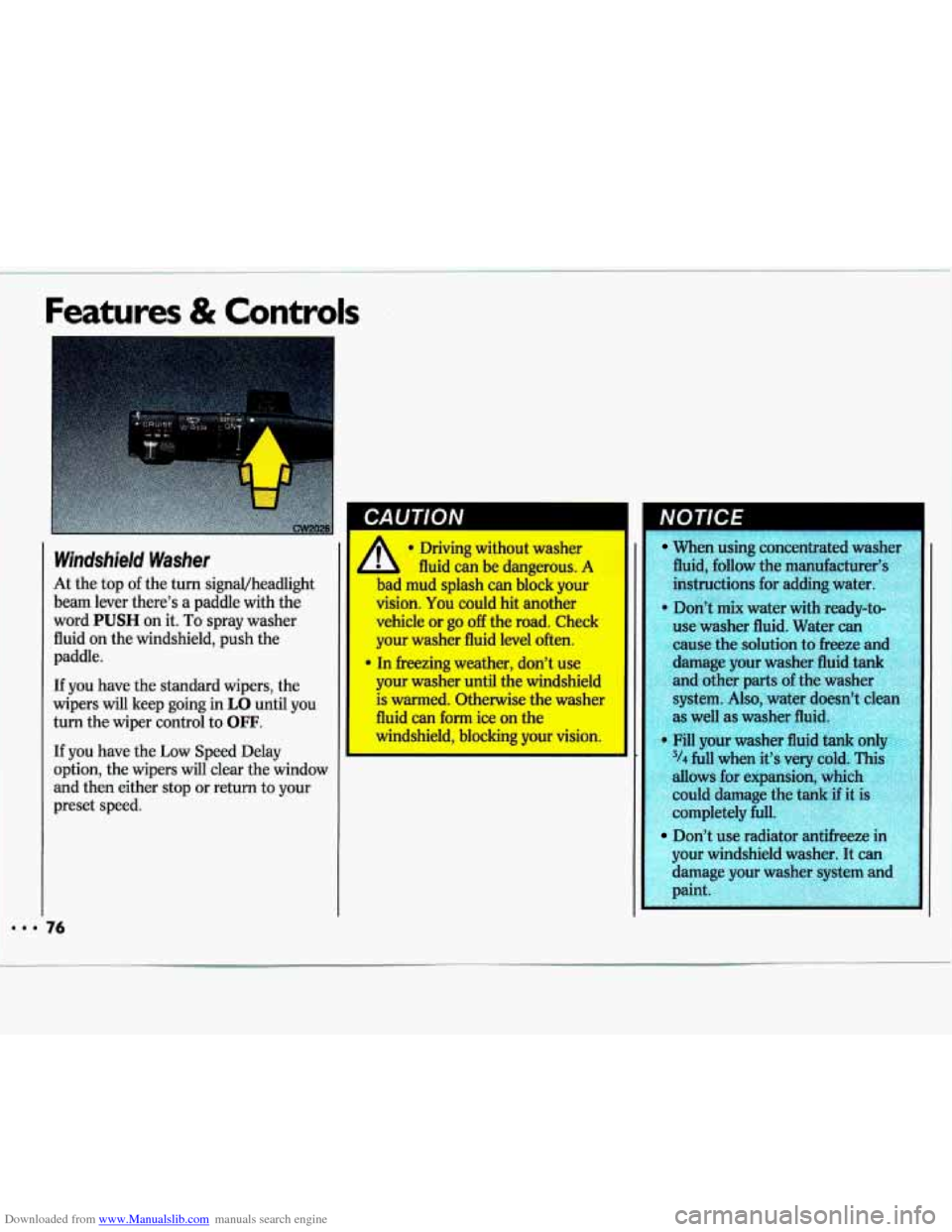
Downloaded from www.Manualslib.com manuals search engine Windshield Washer
At the top of the turn signavheadlight
beam lever there’s a paddle with the
word
PUSH on it. To spray washer
fluid on the windshield, push the
paddle.
If you have the standard wipers, the
wipers will keep going in
LO until you
turn the wiper control to
OFF.
If you have the Low Speed Delay
option, the wipers
will clear the window
and then either stop
or return to your
preset speed.
I CAUTION NOTEE I
\%en using concentrated wash1 1
Ad, follow the manufacturer’s
instructions for adding water.
Don’t mix water with ready-to-
use washer fluid. Water can
cause the solution
to freeze and
damage your washer fluid taI
and ather parts of the washer
as well as washer
flu
Fill your washer fluid tad
3/4 full when it’s very cold. This
allows for expansion, whi
could damage the tank
if i - ompletely full.
I 1 Uon’t use radiator antifreeze in
‘our windshield washer. It can
damage your washer system ant stem.
Also, water doesn” dean
I
I paint.
Page 92 of 324

Downloaded from www.Manualslib.com manuals search engine Features & Controls
Engine Coolant Temperature Warning Light
This light tells you that your engine
coolant has overheated or your radiator
cooling fan is not working. If you have
been operating your vehicle under normal driving conditions, you should
pull
off the road, stop your vehicle and
turn the engine
off as soon as possible.
HOT COOLANT CAN BURN YOU
BADLY!
In
Problems on the Road, this manual
shows what to
do. See the Index under
Engine Overheating.
Engine Coolant Temperature
Gage
(OPTION)
If you have the gage cluster, you have a
gage that shows the engine coolant
temperature. If the gage pointer moves
into the red area, your engine is too hot!
That reading means the same thing as
the warning light. It means that your
engine coolant has overheated. If you
have been operating your vehicle under
normal driving conditions, you should
pull
off the road, stop your vehicle and
turn off the engine as soon as possible.
HOT COOLANT CAN BURN
YOU
BADLY!
In
Problems on the Road, this manual
shows what to do. See the
Index under
Engine Overheating.
Low Coolant Warning Light
(v6 ENGINES)
If this light comes on, your system is
low on coolant and the engine may
overheat. See the
Index under Engine
Coolant and have your vehicle serviced
as soon as you can.
Page 176 of 324

Downloaded from www.Manualslib.com manuals search engine .- I
Problems on the Road
hgine Overheating (CONT.)
If you no longer have the overheat
warning, you can drive. Just to be safe,
drive slower for about ten minutes.
If
the warning doesn’t come back on, you
can drive normally.
If the warning continues, pull over,
stop, and park your vehicle right away.
If there’s still
no sign of steam, you can
idle the engine for two or three minutes
while you’re parked, to see
if the
warning stops.
But then, if you still have the warning,
TURN OFF THE ENGINE AND GET
EVERYONE
OUT OF THE VEHICLE
until it cools down.
You may decide not to lift the hood but
to get service help right away.
LAU I IVN
2.2L L4 Cooling System
When you decide it’s safe to lift the
hood, here’s what you’ll see:
(A) Coolant recovery tank
(B) Radiator pressure cap
(C) Electric engine fan
If the coolant inside the coolant
recovery tank is boiling, don’t do
anything else until it cools down.
All V6 Cooling Systems
When you decide it’s safe to lift the
hood, here’s what you’ll see:
(A) Coolant recovery tank
(B) Radiator pressure cap
(C) Electric engine fan
If the coolant inside the coolant
recovery tank is boiling, don’t do
anything else until it cools down.
I
Page 177 of 324
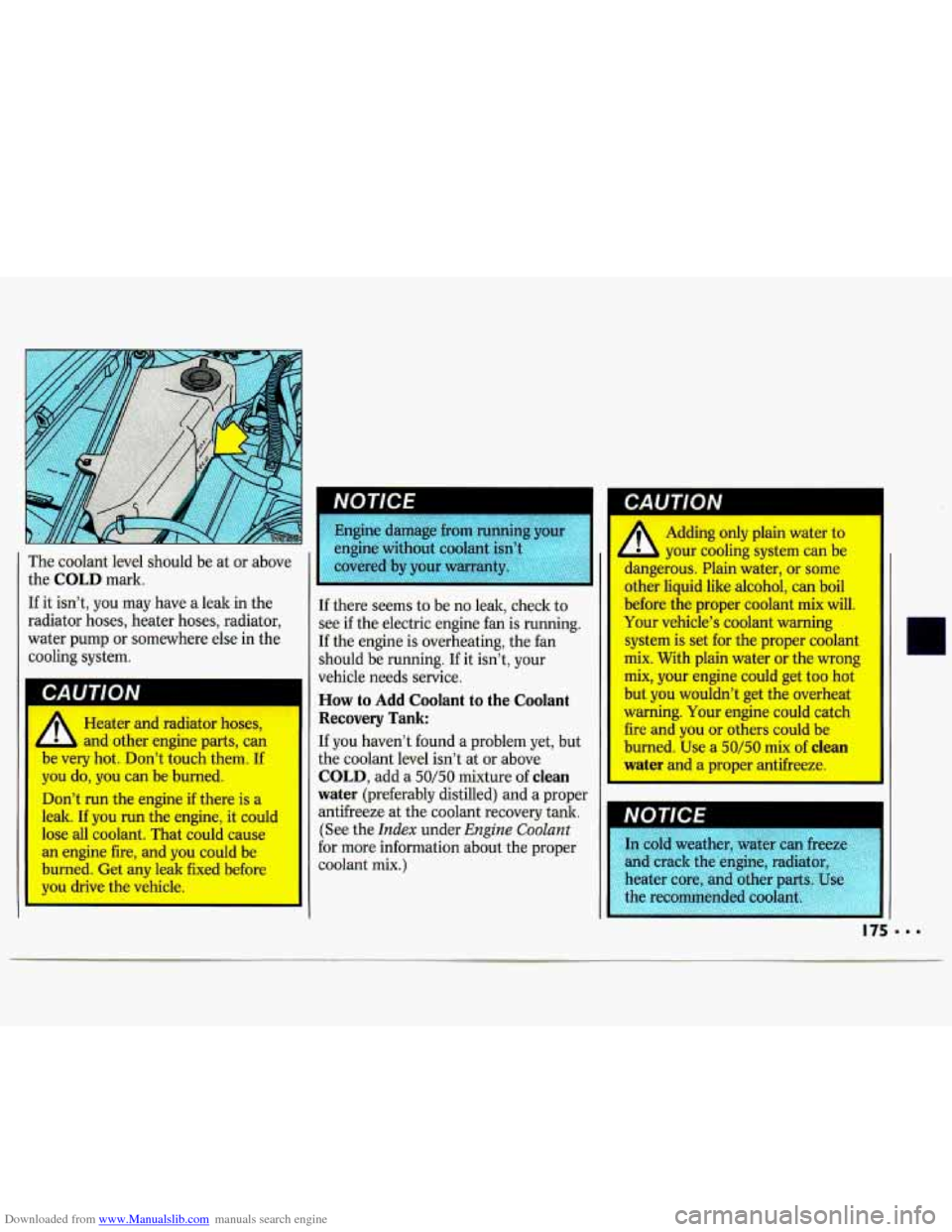
Downloaded from www.Manualslib.com manuals search engine I
The coolant level should be at or above
the
COLD mark.
If it isn’t, you may have a leak in the
radiator hoses, heater hoses, radiator,
water pump or somewhere else in the
cooling system.
Heater and radiator hoses,
L L and other engine parts, can
be very hot. Don’t touch them. If
you do, you can be burned.
Don’t run the engine
if there is a
leak. If you run the engine, it could
lose all coolant. That could cause
an engine fire, and you could be
burned. Get any leak fixed before
you drive the vehicle.
1 NOTlCE CAUTION
If you haven’t found a problem yet, but
the coolant level isn’t at or above
COLD, add a 50/50 mixture of clean
water
(preferably distilled) and a proper
antifreeze at the coolant recovery tank.
(See the
Index under Engine Coolant
for more information about the proper
coolant mix.)
-l
A Adding only plain water to
your cooling system can be
Amgerous. Plain water, or some
~ .ler liquid like alcohol, can boil
before the proper coolant mix will.
Your vehicle’s coolant warning system is set for the proper coolant
mix. With plain water or the wrong
mix, your engine could get too hot
but you wouldn’t get the overheat
warning. Your engine could catch fire and you
or others could be
burned. Use a
50/50 mix of clean
I
I NOTICE
175 .
Page 179 of 324
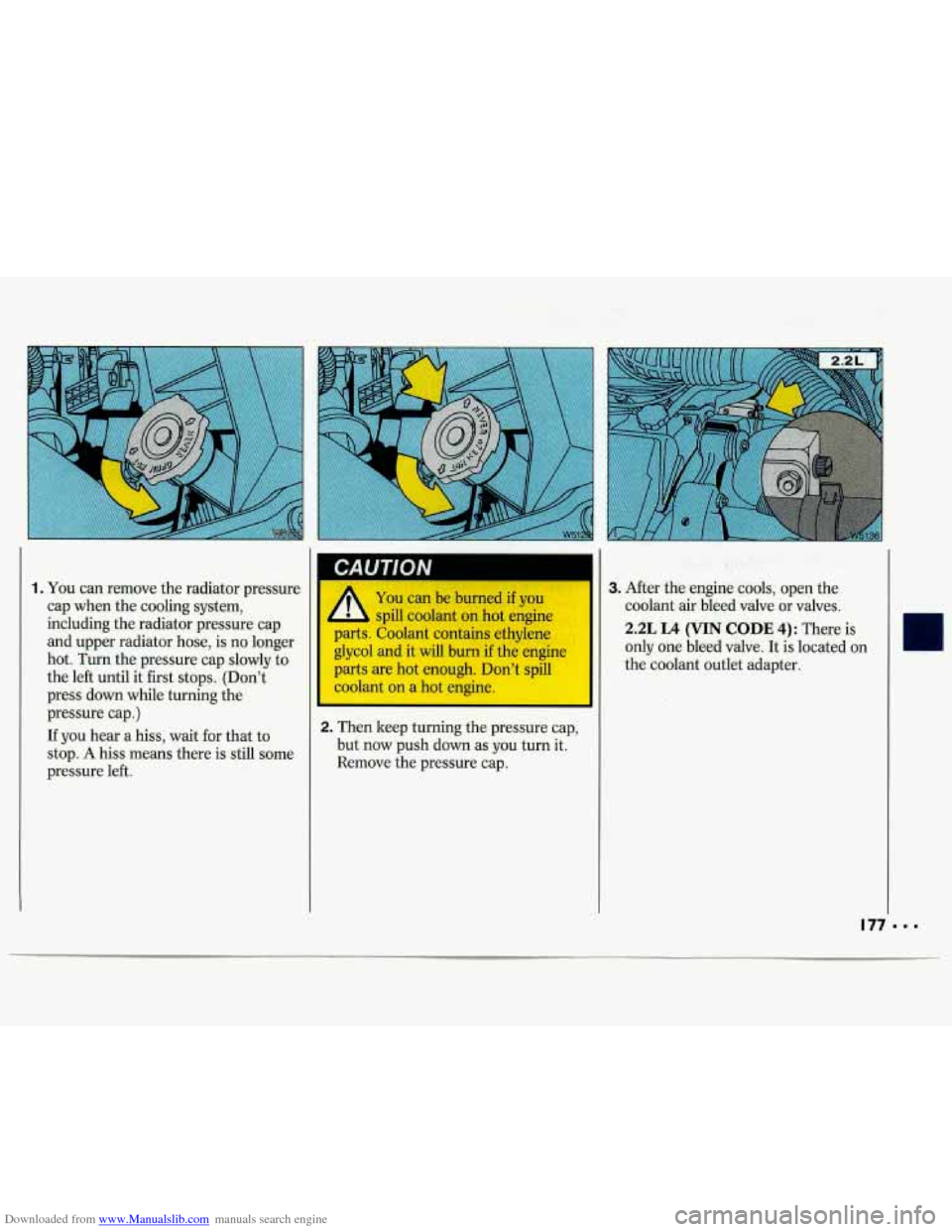
Downloaded from www.Manualslib.com manuals search engine 1. You can remove the radiator pressure
cap when the cooling system,
including the radiator pressure cap
and upper radiator hose, is no longer
hot. Turn the pressure cap slowly to
the left until.
it first stops. (Don’t
press down while turning the
pressure cap.)
If you hear a hiss, wait for that to
stop.
A hiss means there is still some
pressure left. You
can be burned
if you
spill coolant on hot engine
parts. Coolant contains ethylene
glycol and it will burn
if the engine
parts are hot enough. Don’t spill
coolant on
a hot engine. I I
2. Then keep turning the pressure cap,
but
now push down as you turn it.
Remove the pressure cap.
11
3. After the lengine cools, open the
coolant
air bleed valve or valves.
2.2L L4 (VIN CODE 4): There is
only one bleed valve. It
is located on
the coolant outlet adapter.
Page 180 of 324
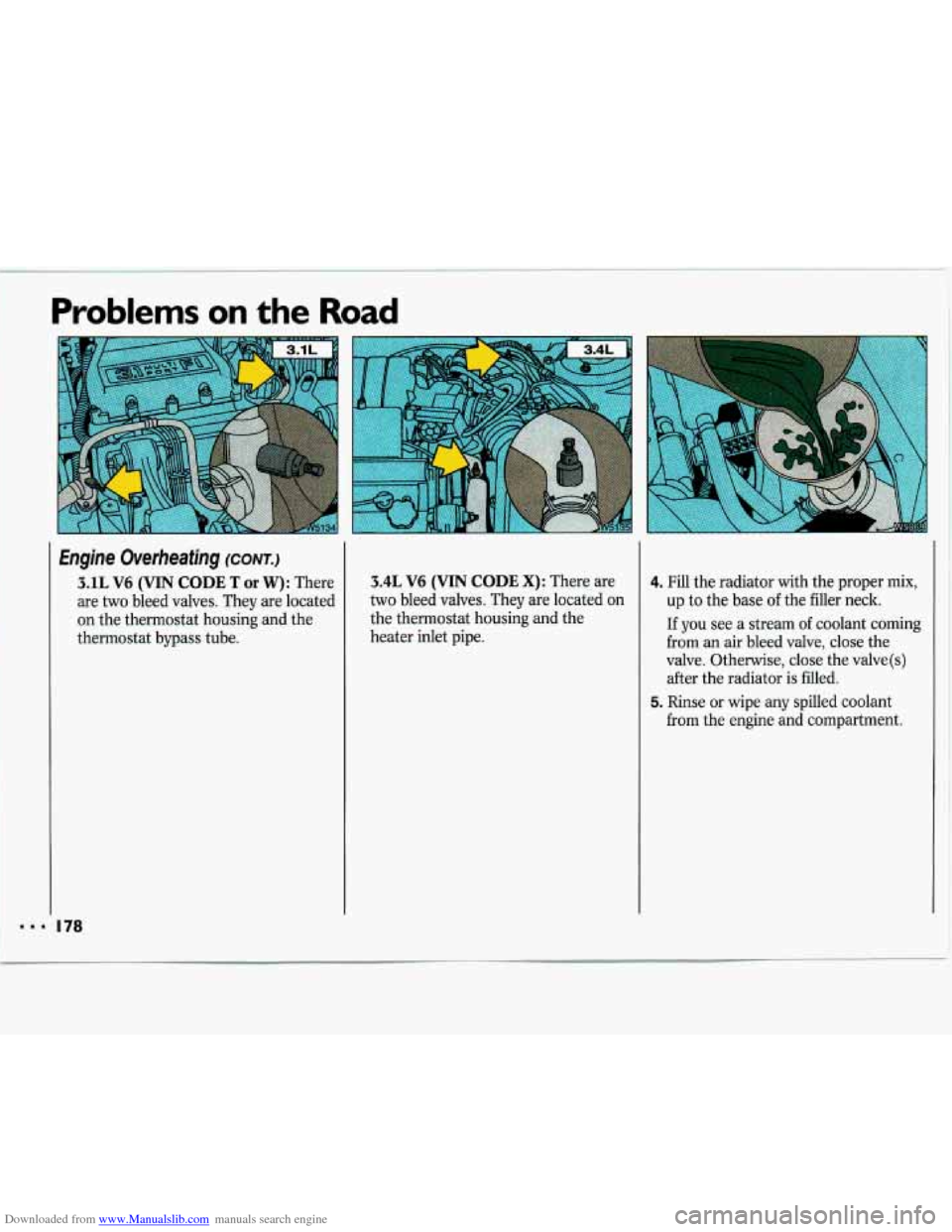
Downloaded from www.Manualslib.com manuals search engine ...
Problems on the Road
Engine Overheating (CONTJ
3.1L V6 (VIN CODE T or W): There
are two bleed valves. They are located
on the thermostat housing and the
thermostat bypass tube. 3.4L V6 (VIN CODE X): There are
two bleed valves. They are located
on
the thermostat housing and the
heater inlet pipe.
I
4. Fill the radiator with the proper mix,
up to the base of the filler neck.
If you see a stream of coolant coming
from an air bleed valve, close the
valve. Otherwise, close the valve(s)
after the radiator is filled.
5. Rinse or wipe any spilled coolant
from the engine and compartment.
I78
Page 181 of 324

Downloaded from www.Manualslib.com manuals search engine 6. Then fill the coolant recovery tank to
the
COLD mark.
7. Put the cap back on the coolant
recovery tank, but leave the radiator
pressure cap off. 8. Start the engine and let it run until
you can feel the upper radiator hose
getting hot. Watch out for the engine
fans.
9. By this time, the coolant level inside
the radiator filler neck may be lower.
If the level is lower, add more of the
proper mix through the filler neck
until the level reaches the base of the
filler neck.
Page 200 of 324
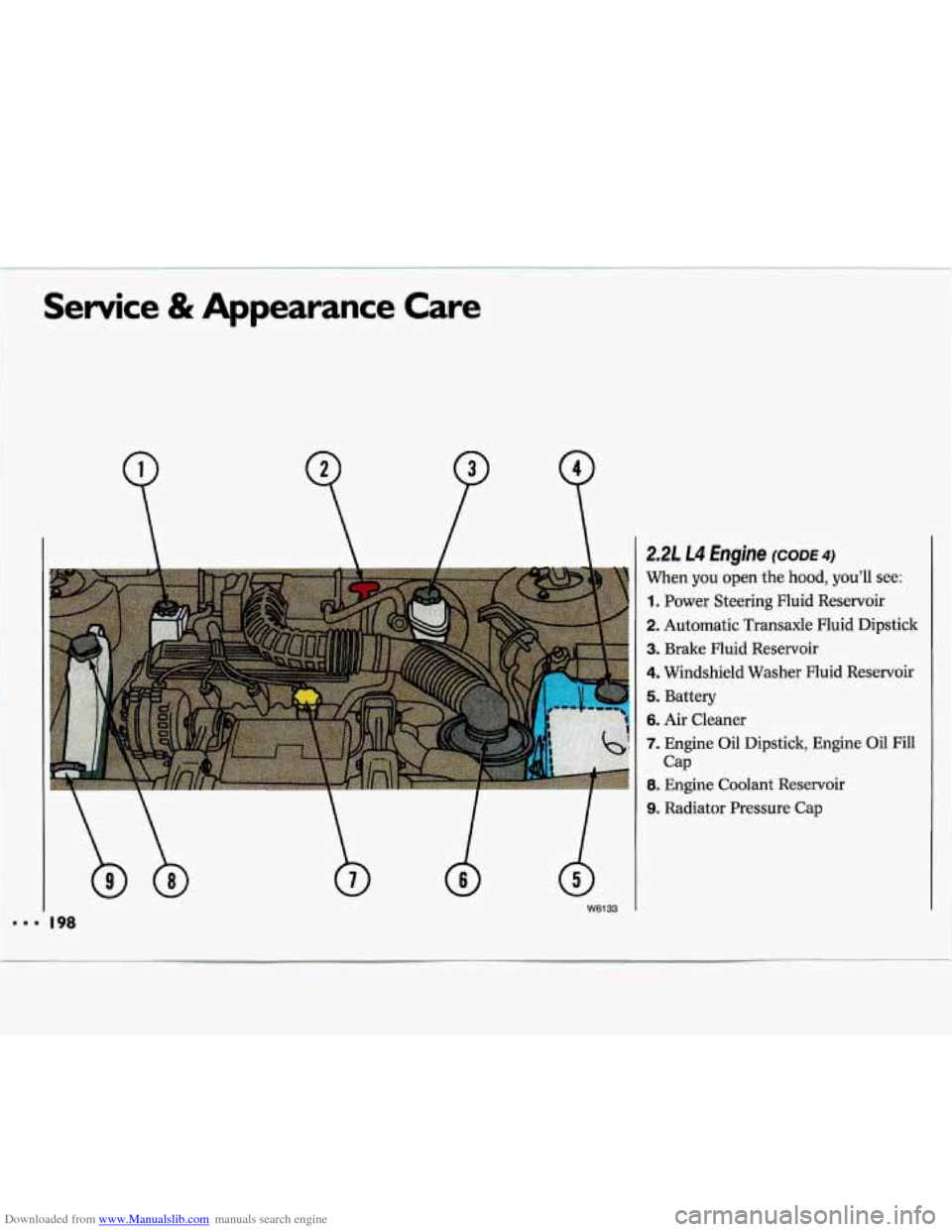
Downloaded from www.Manualslib.com manuals search engine Service & Appearance Care
9 P
. I ...... 2.2L L4 €ngine (CODE 4)
When you open the hood, you’ll see:
1. Power Steering Fluid Reservoir
2. Automatic Transaxle Fluid Dipstick
3. Brake Fluid Reservoir
4. Windshield Washer Fluid Reservoir
..............
b
I
9. Radiator Pressure Cap
W6133 I
Page 201 of 324
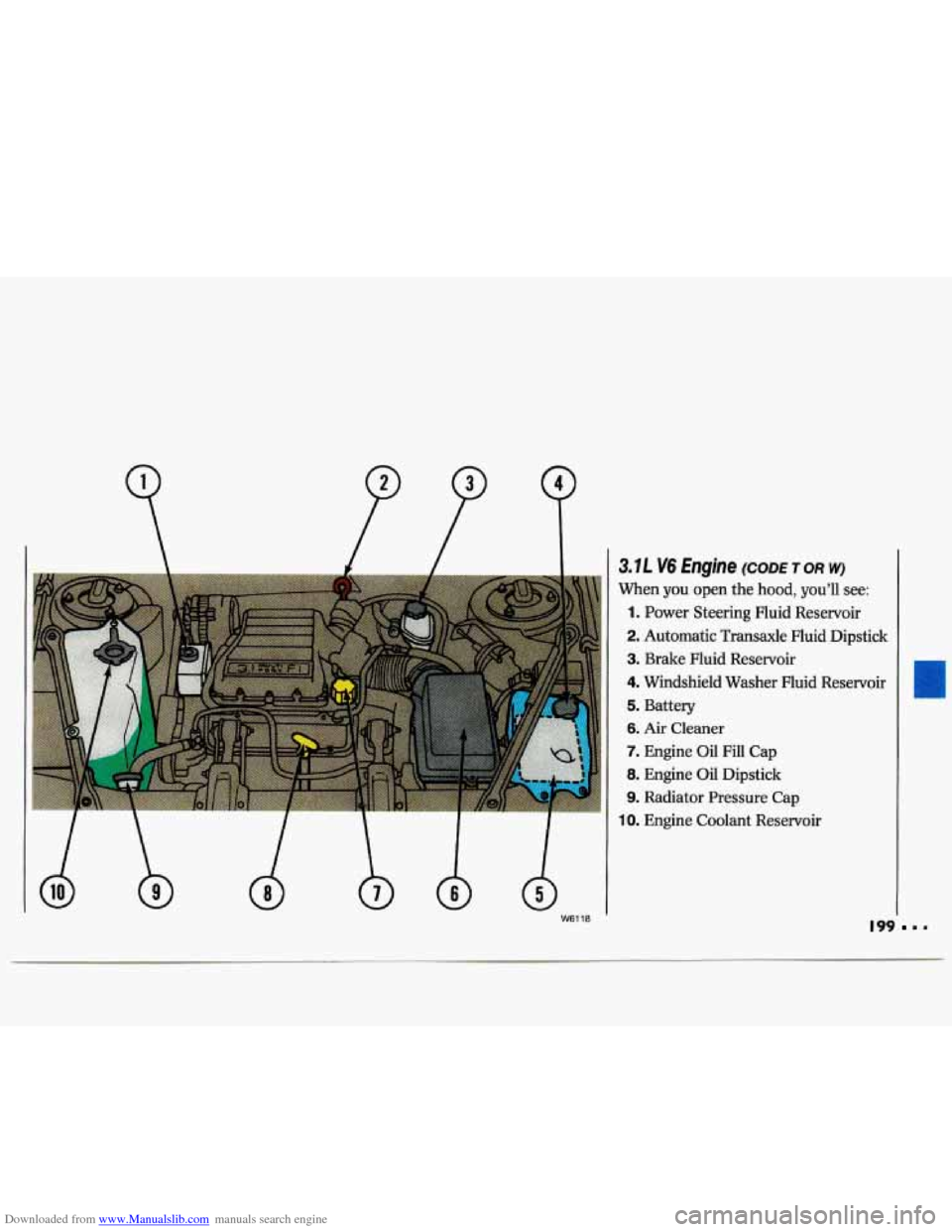
Downloaded from www.Manualslib.com manuals search engine 3.7L V6 Engine (CODE TOR w)
When you open the hood, you’ll see:
1. Power Steering Fluid Reservoir
2. Automatic Transaxle Fluid Dipstick
3. Brake Fluid Reservoir
4. Windshield Washer Fluid Reservoir
5. Battery
6. Air Cleaner
7. Engine Oil Fill Cap
8. Engine Oil Dipstick
9. Radiator Pressure Cap
10. Engine Coolant Reservoir
I99
Page 202 of 324
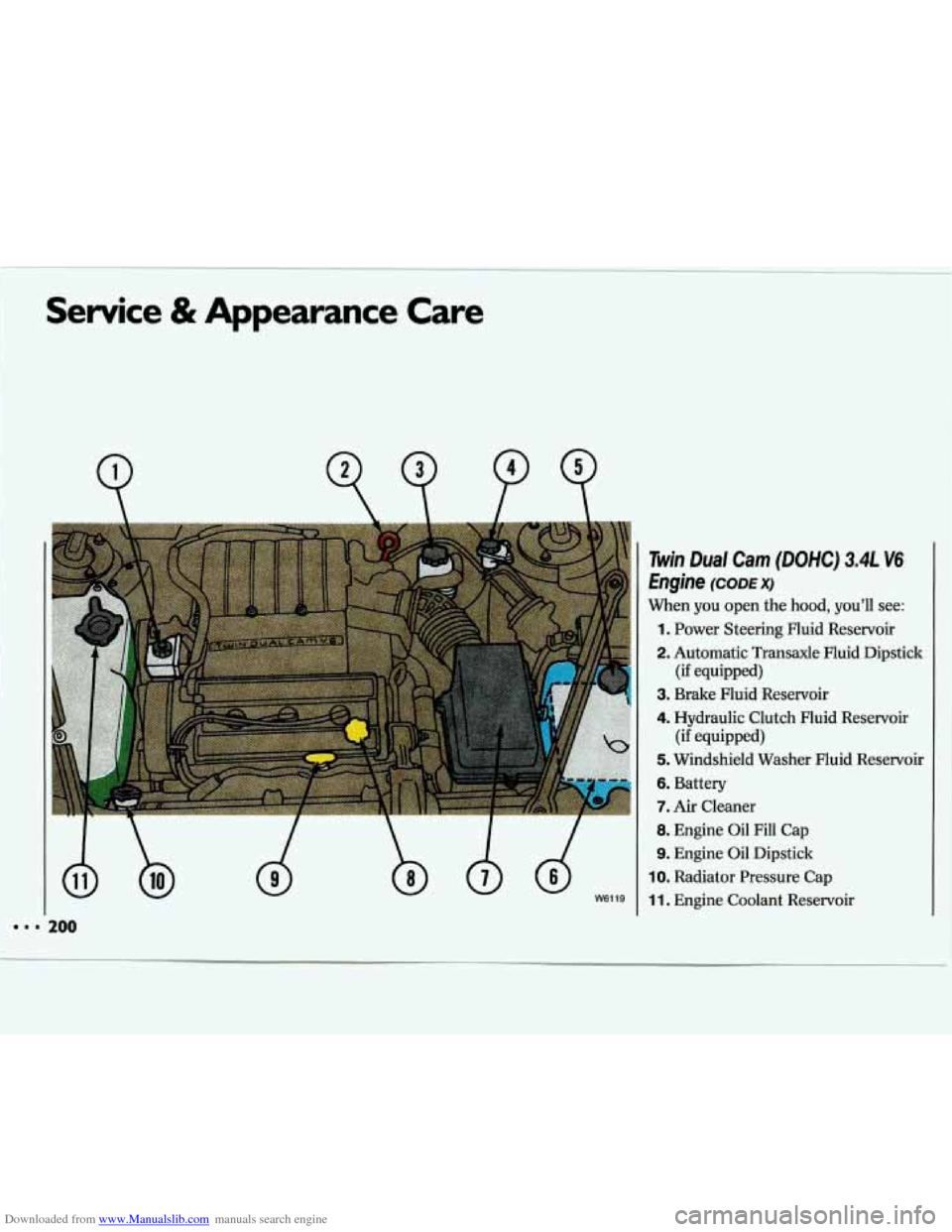
Downloaded from www.Manualslib.com manuals search engine Service & Appearance Care
= 200
W6119
Twin Dual Cam (DOHC) 3.4L V6
Engine (CODE X)
When you open the hood, you’ll see:
1. Power Steering Fluid Reservoir
2. Automatic Transaxle Fluid Dipstick
3. Brake Fluid Reservoir
4. Hydraulic Clutch Fluid Reservoir
5. Windshield Washer Fluid Reservoir
6. Battery
7. Air Cleaner
8. Engine Oil Fill Cap
9. Engine Oil Dipstick
IO. Radiator Pressure Cap
11. Engine Coolant Reservoir
(if equipped)
(if equipped)